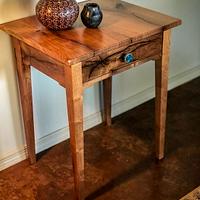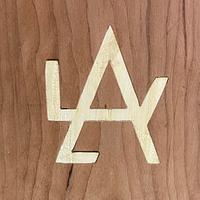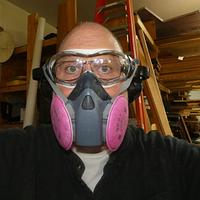
Rich
in about 3 years
Everything Band Saw
I’ll start with one thing that troubled me early on.
The Snodgrass setup wants the gullet to be on the center of the tire. Regular 14” saws tires are about 1” wide. Long ago when I thought I knew everything, I figured that’s never going to work. If I center the gullet of a 3/4” blade on the tire, the blade will hang off the back of the wheel.
If you think about it, that’s how it should be. The tire is crowned, so it will never support the full width of a 3/4” blade. If the blade is centered on the wheel, the teeth are out front with no support. Think of a sheet in the wind. If it’s held in the middle, the front will flap. If it’s held in the front, the front will stay steady while the rear flaps. That’s OK. In fact, when you learn to watch the blade through the cut, you can see that what the back of the blade is doing has no impact on the cut. That’s why the teeth have a set—so the kerf is wider than the blade. It’s the teeth doing the job, and keeping them taut will keep the cut going on track.
Half of what we read or hear about finishing is right. We just don’t know which half! — Bob Flexner
95 Replies
working with my hands is a joy,it gives me a sense of fulfillment,somthing so many seek and so few find.-SAM MALOOF.
Half of what we read or hear about finishing is right. We just don’t know which half! — Bob Flexner
working with my hands is a joy,it gives me a sense of fulfillment,somthing so many seek and so few find.-SAM MALOOF.
I have a new 1 yr old Alpha Harvey. I love it. However I am using the blade that came with it. I am looking for recommendations for replacement blades.
Petey
BTW, IIRC, I think that on band saws that do not have have crowned wheels or tires, you are supposed align the gullet on the front edge of the wheel so that the teeth and set are not affected or damaged by riding on the wheel.
Pete, I do not know how good the blade is that comes with the Harvey, but I have had excellent results with Timberwolf blades. Often the blades comes with bands saws are designed more for cutting relatively thin stock with a fairly high TPI.
A rule of thumb for picking the TPI is that you need a minimum of 3 teeth in the wood at all times. For example, if you are cutting a less than 1" thick piece, a 3 TPI blade is marginal because you only have 2 teeth engaged in cutting at a time.
--Nathan, TX. Hire the lazy man. He may not do as much work but that's because he will find a better way.
--Nathan, TX. Hire the lazy man. He may not do as much work but that's because he will find a better way.
I have also discovered that when you setup a blade this way, it does not require as wide of a blade, even for thick resawing and milling. When I got my first blade for milling green logs, I went with the widest blade that my saw can handle but after experimenting, I never go wider than a 1/2" blade anymore.
I’ve found this to be key. After reading about it and thinking on it, it makes perfect sense. As long as the leading (read: cutting) edge of the blade it supported, and the tension and feed rates are right, the remainder of the blade is really just coasting along (assuming straight line/resaw cuts). I also think that ensuring the gullet is in the middle of the tire really helps to reduce any drift, from a set up perspective. If the tire is more supporting the rear of the blade, the teeth are allowed to wander, and then variance in the wood will push them to the side, as the rear of the blade pivots on the tire. That creates a lever effect on the rear of the blade and causes drift. Same (or similar) to having too high a feed rate. The rear of the blade is forced into the rear guide and then has nowhere to go, so it ends up acting as a pivot point. Continued pressure forces the front of the blade (teeth) off to the side, resulting in drift. The wider the blade, the more pronounced this is…
So, like so much of woodworking, sharp teeth and proper setup result in the most accurate cuts.
Ryan/// ~sigh~ I blew up another bowl. Moke told me "I made the inside bigger than the outside".
working with my hands is a joy,it gives me a sense of fulfillment,somthing so many seek and so few find.-SAM MALOOF.
Interesting info about the flat tires. I didn’t know there was such a thing.
Half of what we read or hear about finishing is right. We just don’t know which half! — Bob Flexner
Ryan/// ~sigh~ I blew up another bowl. Moke told me "I made the inside bigger than the outside".
Hmmm band saw blades.
My first BS is my MM16 which will take a 1-1/4" blade so I've tended to stay with the 3/4"+ blades. The saw came with a factory pair of 4 TPI Olsen blades which were OK, but soon dulled with resawing oak and other harder woods. Timberwolf had good reviews so I bought 3 more with the same profile as the original Olsen's. They cut well for a few resaws, but then also dulled. On to the WoodSlicers. The initial cuts were a dream come true, very sharp. After going through three of these I concurred with others that although they cut great, they dull very quickly, even faster than my Olsen and TWs.
Plenty of warnings about the carbide tipped Resaw Kings from Laguna on smaller than 18" machines. The heat treat and thickness of the metal led to fatigue cracking from the increased flexing around the smaller diameter wheels (this was early 2000's). Finally they came out with a 0.024" thick blade so I bought a 3/4" and later a 1" when on sale. Another thing was that they finally offered a 144" blade which didn't require the weld delays and they were available ready to ship for the sale pricing. I am still running the 3/4" after about 6 years so very happy with the results cutting hard woods like jatoba, ipe, and various rosewoods. Not as smooth as the Wood Slicer but that is why I have a drum sander.
My second BS is a vintage 14" powermatic 141. I got tired of swapping out blades on the 16" when I needed to cut curves. For these needs I use a variety of 1/4" and 3/8" blades, just the cheap ones as they all seem to last for my cutting needs and are very cheap in comparison to the wider/longer resaw blades.
My analysis hinged on the deep gullets. That’s going to be a hotspot for strain. In fact, every break I’ve had started in the gullet. I didn’t realize what was happening at first, I’d just notice that the blade seemed to be thrusting (pulsing?) forward as it ran. Turns out the crack in the gullet starts to open slightly and the blade gets a slight backward bend due to it, and it’s visible when the saw is running. The break always occurred shortly after that began.
Makes me think it’s more suited to larger band saws that take 1” and up blades. The tooth geometry looks to be about the same for 3/4 and 1 inch blades, and the 1” blade has a lot more steel to stand up to the strain.
Half of what we read or hear about finishing is right. We just don’t know which half! — Bob Flexner
I can envision someone sitting at a work station with an oxy-acy torch, holding a carbide chunk with tweezers, and trying to braze 🙂
I bought the 1" RK just for the greater beam strength and illusion that I could get a bit smoother resawing but since I haven't spun that blade up I don't know if there will be any difference.
If you think about it, there are a lot of bend-straight-bend cycles on a blade and the bigger the wheel, the lower the amount of bend.
I keep an eye on things and inspect my blade every so often looking for the beginnings of failure, but even though it still looks fine I'd still never consider one for a 14" until they get a few more years behind the offerings to have worked out the metallurgy.
Do you know the thickness of your blade that failed?
I have "calibrated" my tension gauge to be sure I never exceed the yield point of blades I use as one defense against trashing a $100+ blade.
If/when I get it sharpened, then I'll feel better about it being a good fit for my 16" saw. Hopefully it'll last until the carbide is past the point of further sharpening. At that point I'll feel better about the investment.
Carbide seems the only choice for hard-hardwoods, kinda like what was figured out with table saw blades many decades ago.
I noticed recently that TW sells some carbide tipped BS blades. The smallest size is 181". Not sure what wheel size that equates to but it is about 50" longer than my 17" saw uses.
Speaking of dull blades. Have any of you ever tried to sharpen a non-carbide BS blade yourself? I've seen several Youtubers do that, one who even sharpens new blades when he gets them. I hate throwing away something like that so I decided to give it a try. Not only was it tedious to do but my results were not worth the trouble. It was definitely sharper but I must not have been consistent with my technique because it tended to pull to one side.
--Nathan, TX. Hire the lazy man. He may not do as much work but that's because he will find a better way.
Do yo know the steel thickness of the TW carbide? could be for 18" or even 24" saws but sounds like a no-no for anything smaller.
--Nathan, TX. Hire the lazy man. He may not do as much work but that's because he will find a better way.
They worked ok but it was "puckering" to tension up. I won't be using them again, too much stress on machine and operator.
Looks like they have some recommended blades higher up on the page for green log cutting
My Rikon 18 has flat tires, no rise, at least that I can appreciate. I just put the blade on, and have to address the guides to the placement of the tire. I've had them using most of the tire's width on 1 1/4 wide blades,, and tiny little 1/8" which I pretty much centered, and have never had any issue one way or the other. I think if I ever bought another BS, it would have the non crowned wheels. My thinking back when, and still is those crowns are the Devils work, and it's them, and well, that cast iron flexy frame, that cause all the issues with the 14" Delta, and the clones.
My suggestion is no matter what size you want, get a steel frame, something that will take tension. Save up until you can get one, or pay no more than 100 bux for a cast iron flexy frame saw. That way when you finally break down, and buy a steel frame saw, you won't get spanked on resale.
****
Tool guy I grew up with also does woodworking as a hobby. He says steer clear of them. Something about how they braze all that carbide that makes the band brittle. I've seen and heard about their high priced wonders breaking on saws of all sizes, not just 14's.
I have tried Carbide blades for resaw, and problems exist, The Carbide is good a long long time, but the marriage seems to be the problem. I personally have never seen long life from TW blades, and have almost completely swapped to Starrett blades for all my functions. I just look at a known price, versus a pretty repeatable length of use, and feel like they give me the best bang for my buck as anything out there. That is since BC saw quit Bandsaw blades. I cried the day I heard that. They used to get all my business.













